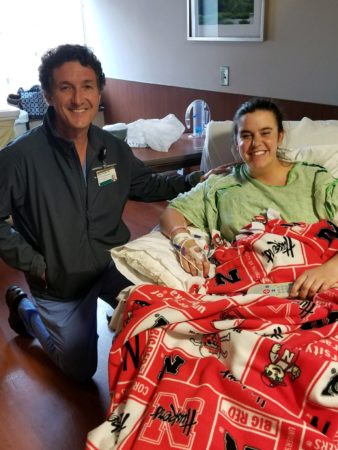
Vanderbilt University Medical Center is the nation’s leading recruitment site for a new study examining the effectiveness of donor nerve grafts to restore sensation to breast tissue following mastectomy and reconstruction.
When breast tissue is removed during a mastectomy, nerves that provide feeling to the breast are severed, often leading to a permanent loss of sensation. The numbness means light touches are not perceived, but it can also be potentially dangerous if a serious injury goes unnoticed.
Plastic surgeons with Vanderbilt Health offer an advanced microsurgical breast reconstruction option called DIEP (deep inferior epigastric perforator artery) flap reconstruction. Patients choosing this type of reconstruction, which uses their own abdominal tissue to form a new breast, are the best candidates to participate in the national ReSensation study.
In the study, plastic surgeons use allograft nerve tissue, or donor nerve tissue that is harvested from cadavers, to reconnect the nerves that remain in the patient’s chest wall to nerves in the transplanted abdominal tissue. The donated tissue serves as a bridge to allow the two nerve segments to grow together. If successful, this leads to the return of feeling to the chest area.
“This is almost the final step in breast reconstruction,” said Galen Perdikis, MD, chair of the Department of Plastic Surgery and the lead principal investigator for the study at VUMC. “We can use the patient’s own tissue to reconstruct the shape and form of the breast, but we’ve never been able to restore the protective and fine sensation to that tissue.”
The ReSensation study is being conducted at 22 study sites nationwide, and more than 70 women have chosen to participate at VUMC to date. Participating patients return to VUMC every three months during a two-year period for a sensory check that measures the level of sensation that has returned to the tissue. Patients also complete a survey that provides more detail on their progress.
Nerves grow at a slow rate, about an inch per month under ideal conditions, so the return of sensation can be a lengthy process. Because of this, the data that researchers obtain through regular patient progress reports are invaluable, Perdikis said.
“Through this study, we’re going to continue to learn what the best technique for this is and what is the most appropriate nerve on the chest to use,” said Perdikis. “For example, is the lateral nerve better than the medial nerve? We’re also looking at the number of axons or nerve fibers in the lateral nerve versus the medial nerve and seeing if that is a determining factor in better outcomes.”
Armed with the knowledge that women in her family had a significant history of breast cancer, Kelly Keogh had genetic testing in 2017 that showed she was positive for BRCA2 mutation. National statistics show that women who have a BRCA2 mutation have an estimated 69% chance of developing breast cancer by age 80.
Keogh lives in New York where she has a busy schedule working in communications for a professional hockey team. Because Vanderbilt-Ingram Cancer Center is a highly reputed National Cancer Institute-designated Comprehensive Cancer Center, and her parents, who had recently moved to Nashville, could care for her after surgery, Keogh chose to have a bilateral prophylactic mastectomy and a double DIEP flap breast reconstruction at VUMC.
Raeshell Sweeting, MD, Perdikis, and Julian Winocour, MD, coordinated her surgery in the operating room in May 2018, with Sweeting performing the bilateral mastectomy and Perdikis and co-surgeon Winocour performing the DIEP flap procedures and re-connecting the nerves using the donor nerve tissue. Although she had the additional procedure to bring sensation back to the reconstructed tissue, due to her distance from VUMC, Keogh opted to not participate in the ReSensation study.
While she said the initial days following surgery were hard, just two months after her surgery, Keogh felt “normal enough” to check an item off her bucket list: skydiving. She tandem jumped with the Golden Knights, the United States Army’s aerial parachute demonstration team.
“To date, it’s the coolest thing I’ve ever done,” she said. “The experience was unbelievable, and I felt just fine.”
As for the return of sensation, Keogh said at the one-year mark following her surgery, she’s regained sensation at the outer region of her reconstructed breasts.
“A couple of weeks after surgery, I started feeling something — a tingling and sometimes a sharp sensation,” she said. “It wasn’t completely numb. To be completely honest, the main thing I was thinking about when I had surgery was my long-term health. I knew people who had this gene in my family that didn’t take care of it ended up getting breast cancer very young. That was my first priority.
“If Dr. Perdikis had told me that I would just never have sensation, I would have understood and been fine with it. But finding someone who was able to put in the extra effort to try to bring that feeling back was an added bonus for me.”
Patients at the Vanderbilt-Ingram Cancer Center and Vanderbilt Breast Center who are scheduled for mastectomies can ask their medical team if they’re candidates for DIEP flap reconstruction and if they can also be considered for the ReSensation study.















